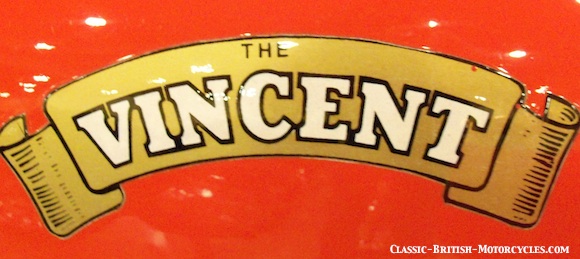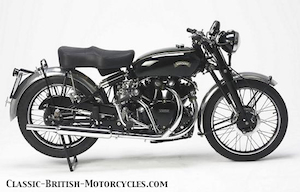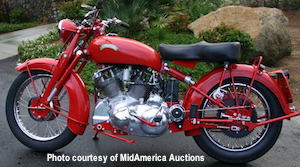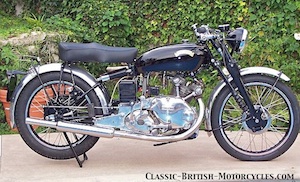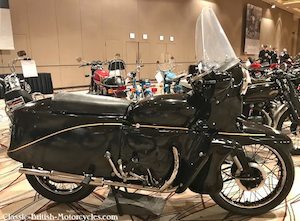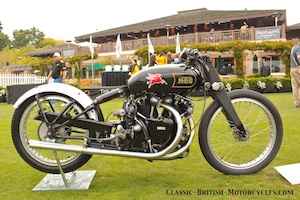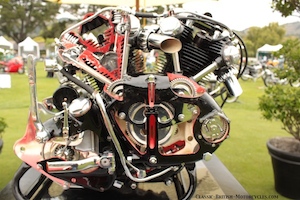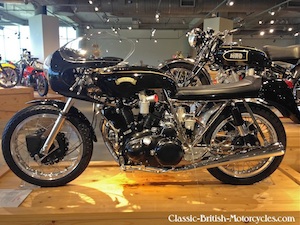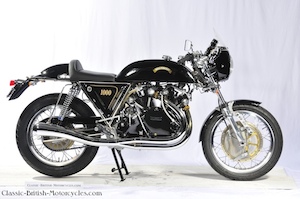SMALL VOLUME, BIG REPUTATION
Vincent Motorcycles have an aura & a cache to them that is vastly out of proportion with their production output. Vincent produced less than 11,000 motorcycles total from the end of World War II until their demise in 1955. It’s amazing how much attention a Vincent Black Shadow, or a Vincent Rapide garners at motorcycle auctions & motorcycle shows, considering how few there are in the world. 11,000 Vincents from 1946 to 1955, or about 1,100 motorcycles per year over 10 model years. In comparison, at their peak, Triumph Motorcycles was building over 30,000 Bonnevilles a month! Just Bonnevilles. Many more when you consider all the other models they built. Yet, Vincent Motorcycles do indeed have an aura of greatness about them, much like old Ferraris command at car shows. They never made very many old Ferraris either, yet they’re legendary, & indeed all the more sought after for their rarity. And like Ferrari, Vincent Motorcycles had high performance credentials: “The world’s fastest production motorcycle.”
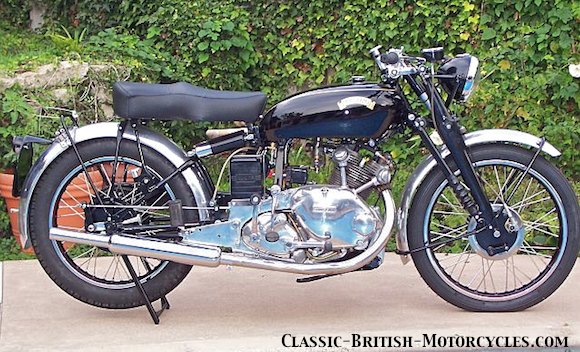
1952 Vincent Comet 499cc OHV single.
A PRISONER’S DREAM
The Vincent story really begins in World War I, when young English Royal Flying Corps pilot Howard Raymond Davis is shot down & taken prisoner by the Germans in 1917. During his internment as a POW, Davis is said to have conceived a design for a motorcycle that he set about trying to produce after the war. In 1924 he takes on EJ Massey as a partner & together they form HRD (Davis’s initials) & build several models using JAP engines. While HRD Motorcycles began winning at the racetrack, they ran at a constant loss financially & by 1928 they went into voluntary receivership. Ernest Humphries, of OK-Supreme Motors bought it for the real estate that came with it (large factory space) & sold off all the other pieces, the HRD name, rights, tooling & materials.
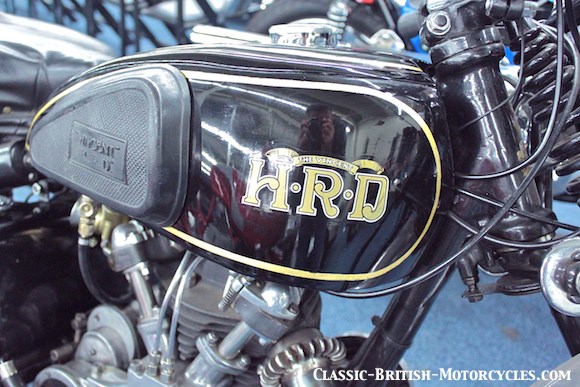
VINCENT BUYS HRD
Meanwhile, Phil Vincent, whose family was very wealthy with Argentine cattle, had built his own motorcycle in 1927 & 1928 with a unique patented cantilever rear suspension (an early version of monoshock). He wanted to go into business producing them, but was advised it would be wise to start with an established name. So, he purchased what was left of HRD from Humphries for a staggering 450 pounds! The new company was named Vincent HRD Co., Ltd. & its trademark was the Vincent name in small letters above the traditional HRD logo. This remained only until US imports grew after WWII. It was deemed that the ‘HRD’-part would confuse customers with the H-D of Harley-Davidson motorcycles, so in 1949 the HRD was dropped & from then on, they were all known as “Vincents”.
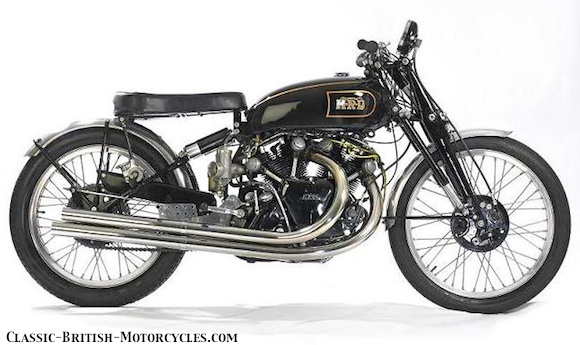
THE EARLY DAYS
1928 saw the introduction of the first Vincent-HRD with a JAP engine & a Vincent cantilever frame. They also used Rudge-Python engines. However, a punishing 1934 racing season at the Isle of Man TT that caused failures in these engines compelled Vincent Motorcycles to design & build their own engines. In 1931 Phil Irving joined Vincent as Chief Engineer. He quickly set about designing a new line of 500cc OHV singles for the 1934 Vincent Meteor. From 1932 to 1936 the awkward Bantam 3-wheeler with a 293cc Villiers two-stroke engine was produced also. Irving left Vincent in 1937 but returned again in 1943.

POSTWAR DEVELOPMENTS
WWII saw Vincent Motorcycles making munitions & marine engines, not motorcycles. But they already had their eye on the emerging US market after the war. In 1944, Eugene Aucott of Philadelphia PA was the first to become a Vincent motorcycle dealer in the US. At this time, Vincent’s only engine was their 500cc OHV singe which powered the Series A Meteor. All Vincents had a unique design feature: the valves had 2 valve guides actuated by a forked rocker arm that operated between the guides, as a way of eliminating sideward thrusts on the valves. These engines produced 26 hp at 5300 rpm & were good for over 90 mph. But, they needed to expand not only their product line but their engine size.
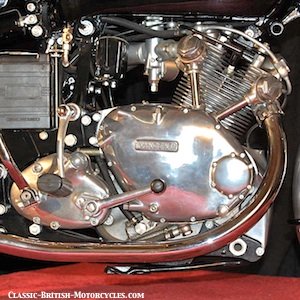
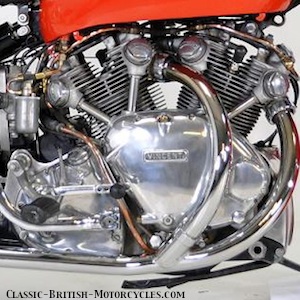
FUNNY STORY…
How the legendary Vincent Rapide V-Twin engine was concieved is certainly one of the most tantalizing legends in all of Classic British Motorcycle-dom. Phil Irving was sitting at the drawing board one day with two tracings of the 500cc single. As things got moved around, the top tracing roughly lined up with the bottom one (identical to the top) at such an angle as to look like a V-twin. With a little cajoling, he lined up the crankshaft centerlines & the timing idler gears & ended up with a 47.5 degree V-twin. The single you see, was canted forward at 23.75 degrees, so this just duplicated that angle to the rear. In doing so, the 1936 Series A Vincent Rapide was born. The 994cc V-twin had 6.8:1 compression, made 45 hp & was good for 110 mph. Absolutely stellar performance in 1936! The Series A (or first generation) engine was somewhat crude when compared with later models, with its non-unit construction & exterior oil lines. The clutch & transmission was also weak. But the Vincent Rapide was still a stunning success for the tiny Vincent-HRD Motorcycle Co. It had a brazed lug frame with Vincent’s patented cantilever rear suspension & a girder front end.
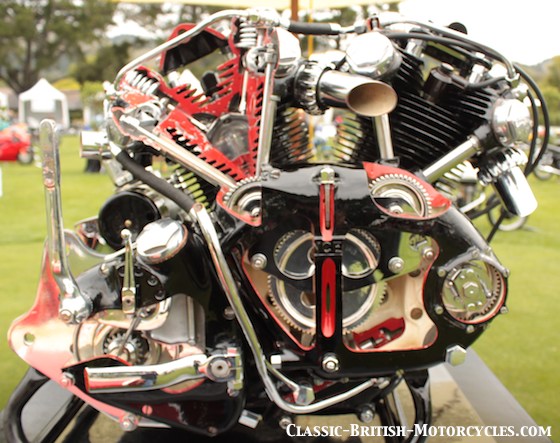
Check out this incredible Vincent Black Shadow V-Twin Engine Cutaway. Brought to you by the Vincent Motorcycle Owner’s Club. Nice work, lads. For a complete 8-picture tour of this wondrous thing, check out our page, Vincent Black Shadow Engine Cutaway.
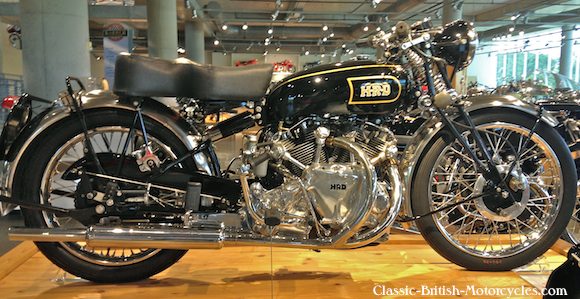
ABOVE: 1953 Vincent Rapide Series C.
SERIES B IMPROVEMENTS
It wasn’t updated until after WWII with the Series B 1946 Vincent Rapide. Now the oil lines were all internal & the separate engine cases were incorporated into one major housing in a ‘unit-construction’ format. The V-angle went from 47.5 degrees to 50 degrees & many internal improvements were made. The engine now became a stressed member of the frame, a revolutionary concept at the time & one not revisited until the 1970s. The backbone with the steering head carried the oil & was attached to the top of the engine. The cantilever rear suspension setup was bolted to the back. Dual SLS (Single Leading Shoe) brakes were front & rear & the QD (Quick Detachable) rear wheel was reversible, with different sprockets on the 2 sides to give different gearing options.
INDIAN VINCENTS
Starting in 1946, Indian Motorcycles of the US became the importers for Vincent. Having changed hands during the war, the new owners of Indian Motorcycles wanted out of the heavy V-twin business & wanted to start building bikes like the British vertical twins. Their design was awful, so they changed strategies & became the exclusive US distributors for several British makes including AJS, Matchless, Royal Enfield & Norton Motorcycles. And now Vincent. It is rumored that an Indian Chief was actually shipped to Vincent’s Stevenage factory in England to be fitted with a Vincent Rapide engine with the idea of considering it for production. It never happened.
SERIES C
In 1948, the Series C was introduced with the Vincent Rapide line. The Series C differed from the Series B Vincents in that they had ‘Girdraulic’ telescopic forks instead of the old girders. The engines, while essentially unchanged, were massaged to yield even more power. The Vincent Black Shadow had 54 hp at 5700 rpm & was good for 125 mph, hence the title “The World’s Fastest Production Motorcycle”. Black Shadows are instantly recognizable by their blacked-out engines.
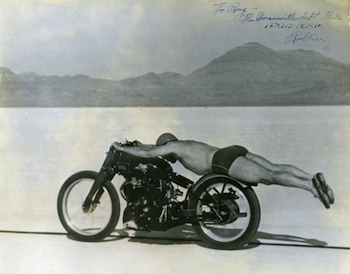
THE BATHING SUIT BIKE
They weren’t kidding when they called themselves “The World’s Fastest Production Motorcycle”, because on September 13, 1948, it became official. At the Bonneville Salt Flats, Rolland “Rollie” Free took a Vincent Black Shadow on several high speed runs but failed to break the 150mph barrier. He determined that the wind resistance of his clothing and sitting in a riding position was keeping him from “The Big 150”. So, he stripped down to nothing but a Speedo swimsuit, a bathing cap and a pair of borrowed sneakers, removed the seat, lain prone on the back fender and proceeded to break all records with a 2-way average of 150.313 mph (241.905 km/h). Vincent Motorcycles built the world’s fastest motorcycle of any type. The photo is probably one of the most iconic photos in all of motorcycle-dom. The bike is affectionately known as “The Bathing Suit Bike” and everyone knows exactly what you’re talking about.
BELOW: This is the actual 1948 Vincent Black Lightning that Rollie Free rode into history that fine day in 1948, the one-and-only Bathing Suit Bike. It was on display at the Quail Motorcycle Gathering in 2011
.
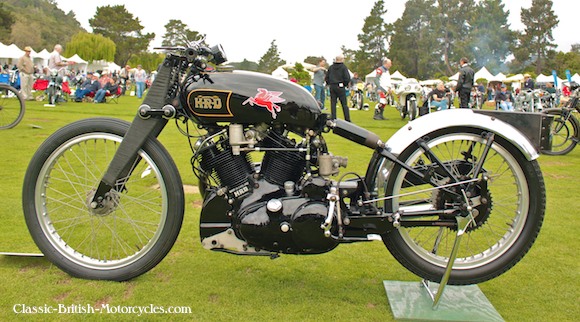
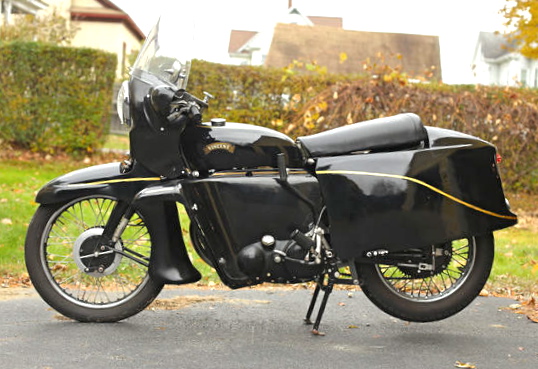
ABOVE: This 1955 Vincent Black Prince shows the direction that they believed motorcycles were headed: fully-enclosed bodies. They were about 50 years too early.
THE SHADOW KNOWS
Most Vincent Motorcycles were black in those days. Just 15 ‘White Shadows’ in, you guessed it, white were sold in 1952. Just 16 Vincent Comets were sold in red in 1950. And 31 Vincent Grey Flashes were built. That’s it! Everything else was black!
ENCLOSED BODIES
Series D was never a name that Vincent Motorcycles actually assigned, but the developmental changes made with the 1954 model year were significant enough to be referred to as such by the general public. Sales were slow & in a desperate effort to turn things around Vincent came out with a fully-faired (fully-enclosed) line of motorcycles. The 1954 Vincent Victor was a Victor Comet with a full body. The Victor Black Knight was a fully-enclosed Rapide. And the Vincent Black Prince was a fully enclosed Vincent Black Shadow. They weren’t well received & did nothing to turn ailing Vincent’s fortunes around.
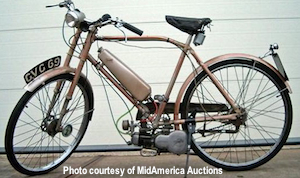
A CRAZY IDEA THAT FAILED ANYWAY
Crazy ideas must have started looking pretty good to them at this time, as they resurrected their trike that failed back in 1930s. This time, instead of a weak JAP or Villiers small engine, it would be powered by the 998cc Vincent Rapide V-twin engine & was capable of speeds as high as 117 mph! This crazy Vincent 3-Wheeler was configured like a small delivery van & had a car seat & a steering wheel, but no reverse or electric start! It too was a failure, on this, its second time around. They even stooped so low as to sign on as the importer for NSU mopeds in their quest to stem the flow of red ink. At first this wasn’t going too well for them. They sold just 160 123cc two-stroke NSU Foxes & 40 98cc OHV 4-stroke models. But when they started carrying the “NSU Quickly” moped in 1954, they promptly sold 20,000 of them the first year. Things went so well that NSU decided to pull their contract & start importing them themselves.
THE END IS NEAR
By 1955, the losses were piling up so high that Phil Vincent announced that motorcycle production would cease. But he vowed that Vincent Motorcycle parts would always be available, and in fact they are, even after all these years. Yet another testament to the solidity of the Vincent Motorcycle legend.
THE END
After that, the focused on engineering, building industrial engines & the Amanda Water Scooter, perhaps the world’s first personal watercraft. Nothing really hit for them. They sought to secure a lucrative government contract to build engines for target drone planes, but this too fell through. In 1959, the Vincent Motorcycle Co. went into receivership.
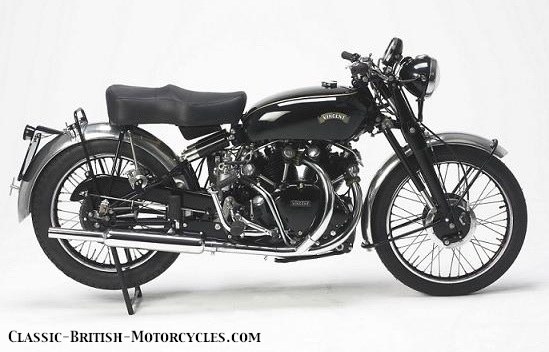
1953 Vincent Black Shadow Series C. Arguably the last of the great Vincent Motorcycles.
THE NAME LIVES ON
But, such is the power of the Vincent name & reputation, that the story doesn’t end there. Vincent V-twin engines continued to be dropped into other types of frames, the most famous of these being the Norvin, a Vincent engine in a Norton Featherbed frame. Another is the Egli-Vincent, of which about 100 were produced from 1967 to 1972 by specialty frame builder Fritz Egli of Switzerland. They continue to be produced today, both authorized & unauthorized. 2 other enterprises were established to try to capitalize on the Vincent name. RTV Motorcycles had plans to build a line of modern, state-of-the-art motorcycles on the Vincent mold with 1000cc & 1200cc V-twins. They managed to build just 4 bikes before going belly-up in 1998. Lastly, Vincent Motors USA acquired the Vincent trademark in 1994 & by 1998 had spent $2Million developing a modern motorcycle with “the Vincent look” & wearing a Vincent badge. It was to be powered by a Honda RC-51 V-twin engine. But before things could really get rolling for the San Diego-based company, founder Bernard Li was killed in a motorcycle accident & his dream with him.
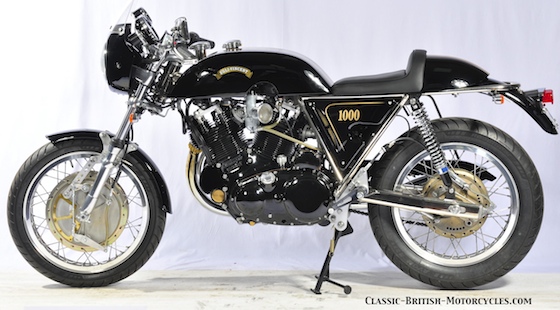
ABOVE: This is a 1970 Egli-Vincent. These hand-built bikes had beautifully-crafted chrome moly frames that were meticulously brazed together with the prettiest beads I’ve ever seen, then nickel-plated. This one was heavily customized in modern times, turning it into a wicked cafe racer. I caught this beauty at my studio shoot at the Clubmans All-British Show in 2011.
Vincent Motorcycles MODEL-BY-MODEL
VINCENT BLACK SHADOW
1000cc OHV V-twin
Series C: 1948-53
Series D: 1954-55 Black Prince,
The most famous of all Vincent motorcycles w/54hp @ 5700 rpm stock. It broke the world speed record in 1948 at 150.313 mph. All Shadows have blacked-out engines.
VINCENT RAPIDE
998cc OHV V-twin
Series A: 1936-45
Series B: 1946-48
Series C: 1948-55
Series D: 1954-55 Black Knight
The original Big Vincent V-twin. Series A was non-unit. Series B, C & D were unit construction. Black Knight was the fully-faired version of the Vincent Rapide.
VINCENT COMET & METEOR
500cc OHV single
Series A Meteor,Comet,Comet Special,TT Replica, 34-46
Series B Meteor & Comet 1946-48
Series C Meteor,Grey Flash 1948
Series D Victor 1954-55
This single was half of the V-twin. Built throughout Vincent Motorcycles entire history.
VINCENT BLACK PRINCE
998cc Black Shadow V-twin
This elegant fully-enclosed touring bike may have been ahead of its time. It was Vincent’s last gasp, alas too little, too late.
This is the actual 1948 Black Lightning that broke the world motorcycle speed record in 1948, piloted by Rollie Free wearing only a bathing suit!
Take an 8-picture, 360-degree Round Robin-tour of the legendary Vincent Black Shadow V-twin Engine. This gorgeous cutaway display was presented at the Quail Motorcycle Gathering by the Vincent Owner’s Club. The quality & detail of this piece were mind-boggling. Enjoy…
1968 EGLI-VINCENT
Fritz Egli built just 100 Egli-Vincent frame kits, which were each outfitted uniquely by their builders.
1970 EGLI-VINCENT
Swiss racer Fritz Egli created a whole new racing frame for the Vincent Black Shadow 998cc V-twin. It handled superbly, and it was gorgeous!!
Check out these VINCENT BOOKS
Vincent Motorcycles (Crowood Motoclassics)
Original Vincent Motorcycle: The Restorer’s Guide to postwar singles and twins (Original Series)
Illustrated Vincent Motorcycle Buyer’s Guide (Illustrated Buyer’s Guide)
Vincent (Osprey Color Library)
Vincent from 1938, Road Tests and Features from the Motorcycle & Motor Cycling
Know Thy Beast: Vincent Motor Cycles
Vincent 1945-1980 Gold Portfolio
Vincent Motorcycles: The Untold Story since 1946
For more like this, please visit our
 |
PLEASE BUY MY NEW E-BOOK HERE 12 Chapters & over 100 original photos. My best work yet. ONLY $4.99! Thank you, Andy Tallone, your humble author Click here to buy now: |


